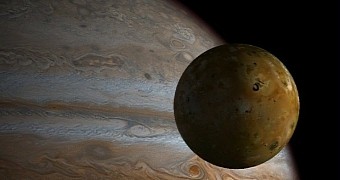The movie industry has a knack for making aliens into vicious monsters thirsty for human blood, and you can’t really blame it for doing so. Having teeny tiny microorganisms travel from deep space all the way to Earth only to chase people around would hardly a blockbuster make.
And yet, this is precisely what scientists over at US space agency NASA have in mind when they say they hope to soon find alien life: microscopic life forms similar to the bacteria that populate our planet by the gazillion.
How soon is soon?
Earlier this year, during a panel discussion at NASA’s headquarters in Washington DC, space agency chief scientist Ellen Stofan promised us that we would have strong evidence of alien life within 10 years and definite proof in about 20 years, 30 tops.
Then, just days ago, NASA Administrator Charles Frank Boden Jr. sat for a Sky News First News Hotseat interview and argued that, given how many planets populate the cosmos, it does not make sense for Earth to be the only one able to sustain life.
“I do believe that we will someday find other forms of life or a form of life, if not in our solar system then in some of the other solar systems - the billions of solar systems in the universe,” he said.
Well, it looks like this “someday” that Charles Frank Boden Jr. mentioned might be sooner than many probably expect. Not to drag out the suspense, it looks like we might just meet Ellen Stofan’s deadline and find proof of alien life in just a few decades.
Sometime in the 2020s, NASA plans to launch yet another probe into deep space and have it explore Jupiter’s moon Europa. At least for now, this orb is our best shot to find alien life in our solar system.
Introducing Europa
As mentioned, Europa is one of Jupiter’s moons. Specifically, it is the sixth-closest moon of this planet and the smallest of its Galilean satellites, i.e. the four largest moons of Jupiter discovered by Galileo Galilei in 1610. The other three Galilean satellites are Io, Ganymede and Calisto.
Europa is estimated to have a diameter of about 3,160 kilometers (roughly 1,950 miles), which makes it slightly smaller than our Moon, whose diameter is one of nearly 3,474 kilometers (2,159 miles).
Its name might sound a whole lot like Europe, but the fact of the matter is the orb was not named after the continent. Rather, it bears the name of one of the god Zeus’ lovers. In fact, all of the four Galilean satellites were named after lovers of Zeus described by Greek mythology.
Does it hide alien life?
Scientists agree that, in order for life to emerge and thrive on an orb, there are three conditions that are paramount: liquid water, an energy source and organic compounds to function as the building blocks of biological processes leading up to the rise of life forms.
Data delivered by NASA’s Galileo spacecraft and later on by the Hubble Space Telescope indicates that Europa meets at least two of these criteria. Thus, researchers have reasons to believe that this moon of Jupiter hides a massive ocean under its crust and that this ocean is not, well, idle.
Instead, water vapors imaged by Hubble, especially around Europa’s south polar region, hint at the presence of source of heat not very different from the hydrothermal vents documented here on Earth. If Europa hides hydrothermal vents, they might have provided the energy needed for life to emerge.
Besides, the myriads of atomic particles constantly flung in Europa’s direction by Jupiter’s gravitational field could have also delivered both the building blocks and the energy needed for life forms to come into being on this celestial body in our Solar System, NASA scientists explain.
“Atomic particles trapped in Jupiter’s powerful magnetic field crash into Europa’s icy surface with great energy, producing chemical compounds that could be used by living things. This process provides a possible energy source that mimics the life-supporting energy of Earth’s atmosphere.”
NASA’s Europa mission
The spacecraft that NASA wants to send to explore Europa is expected to complete at least 45 flybys of the orb. Mind you, the probe will not be searching for alien life forms per se. Armed with a total of 9 instruments, it will try to determine whether or not Europa is habitable.
Thus, it will attempt to measure the thickness of the moon’s icy shell and it will seek to find definite proof of a subsurface ocean, maybe even make observations concerning its chemical composition.
If the moon really does hide alien life forms as researchers suspect, this mission that space agency NASA now has in the works should find proof of it. That’s right, it might be only a matter of years until we find that we are not alone in the universe.

 14 DAY TRIAL //
14 DAY TRIAL //